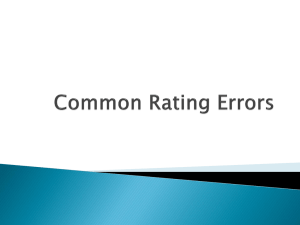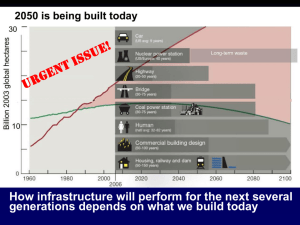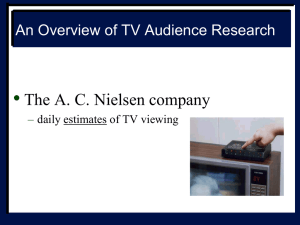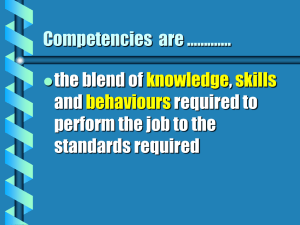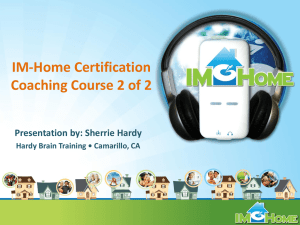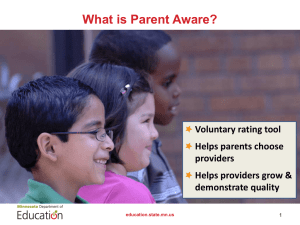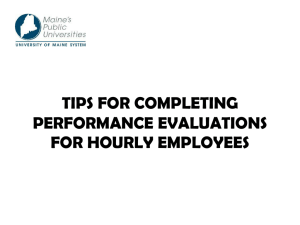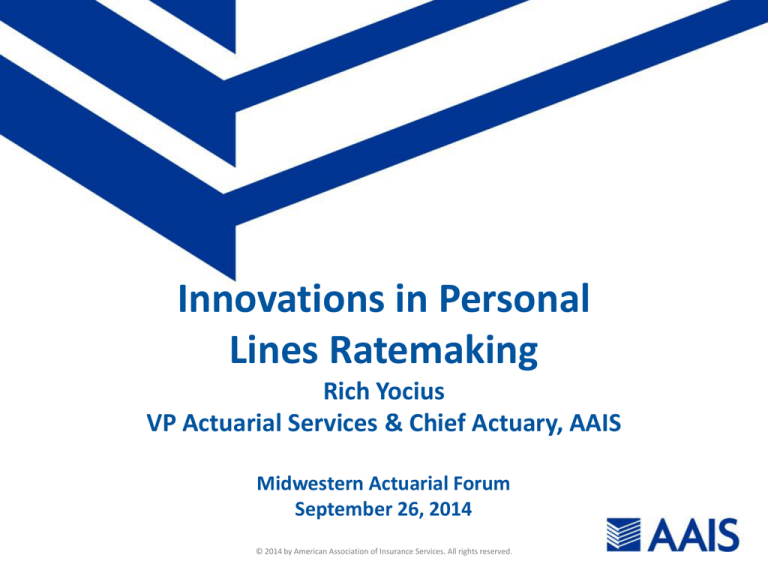
Innovations in Personal
Lines Ratemaking
Rich Yocius
VP Actuarial Services & Chief Actuary, AAIS
Midwestern Actuarial Forum
September 26, 2014
© 2014 by American Association of Insurance Services. All rights reserved.
A story…
Discussion Outline
Historical perspective on rating plan innovation
Examples of notable changes in the past
Recent trends
Role of actuaries in driving, evaluating, and supporting rate
refinement
Historical Perspective
© 2014 by American Association of Insurance Services. All rights reserved.
4
PL Competitive Market through the 1980s
Very similar classifications
Similar classification assignments across companies (e.g.
similar age breakouts for auto)
Very similar policy contracts
Similar coverage options
With similar rating plans, rate competition happened by
leveraging differences in factors or overall rate level
Used marketing and underwriting to drive fewer subsidized
risks and more subsidizing risks
Develop company niches to take advantage of rating plan
inefficiencies and expense differences
Traditional Rating Variables
Homeowners
Private Passenger Auto
Territory
Territory
Fire Protection Class
Age, Gender, Marital Status
Construction Type
Usage (annual mileage, pleasure/work)
Protective Device Credits
Driving Record
Age of Home
Multi-car
Occupancy (single or multi-family)
Basic Vehicle Characteristics (symbols)
Coverage (AOI, deductible, optional
endorsements)
Coverage (limits, deductibles, optional
coverages
Multi-Line/Multi-Policy Discounts
6
Notable Innovations
1939: Allstate introduces auto rating by age, mileage and use
Late-1950s: Companies began introducing rating by driving record
1987: Allstate introduces Allstate Advantage Discount – tiered
discount including multi-policy/multi-line
1991: Progressive pilots the use of credit/insurance score (full-scale
rollout in 1996)
Mid-1990s: Companies begin using cat modelling for HO rates in the
wake of Hurricane Andrew
2004: Progressive pilots usage-based insurance
2005: Allstate introduces “Your Choice Auto” package, including
accident forgiveness, deductible rewards, safe driving bonus and
new car replacement (for an additional premium)
7
Recent Innovations
© 2014 by American Association of Insurance Services. All rights reserved.
8
Changing tides in PL innovation
Companies developing and marketing non-traditional rating variables
Even when common rating variables are used, there is divergence in
classification assignments
– Proprietary insurance scoring (credit) models
– Definition of “married” in auto classification
– Telematics – devices, scores, frequency of updates, etc.
– HO By Peril – different perils and rating plans
– Tiering programs
“Upsell” options for future benefits – pay more now to save later
Increased use of incentives for not having (or filing) a claim
– Vanishing deductibles
– Claim-free rebates/refunds
New coverage options
– ID Theft
– New/newer car replacement
9
So, what changed?
More, better data
Improved computing capabilities
Application of advanced statistical techniques to insurance
Advertising arms race
Quote aggregators
Comparative raters
Ease of comparison shopping
Commoditization of auto and homeowners insurance – price
becoming more critical to shoppers
10
Recent Innovations
Usage-based insurance/telematics
By-peril rating for homeowners
Price optimization
Roof type rating
Cross-product rating variables (e.g. using auto characteristics for
rating homeowners)
“Green” discounts
– Paperless
– Hybrid/electric
Early shopper/advance purchase discounts
Paid-in-full discounts
Occupation rating
Affinity discounts
11
Recent Innovations – Some behavioral
Usage-based insurance/telematics
By-peril rating for homeowners
Price optimization
Roof type rating
Cross-product rating variables (e.g. using auto characteristics for
rating homeowners)
“Green” discounts
– Paperless
– Hybrid/electric
Early shopper/advance purchase discounts
Paid-in-full discounts
Occupation rating
Affinity discounts
12
By Peril Homeowners
Enables varying rating classifications and factors by covered
peril (e.g. roof type for wind/hail perils)
Requires loss detail by cause of loss
How many perils to rate separately?
Which rating factors should apply to which perils?
How should the rating factors vary by peril?
Post-implementation data needs
13
Auto Telematics/Usage Based Insurance
Different technologies used by carriers
Fulfillment and communication issues
Varying data elements used to produce score
Discounts only vs. discounts & surcharges
Frequency of score updates
Post-implementation data needs
14
Changing paradigms
Loss-based analysis
Loss- and expensebased analyses
Policy term analysis
Lifetime value
analysis
Simple,
understandable,
intuitive
Complicated,
interdependent,
“black box”
15
Changing paradigms
Policy
Household
view
view
“Build it and they
will come”
Rating plans as part
of broader product
management
Little customer
control over class
assignment
Customers can
affect their rate
classifications
16
Untapped Opportunities?
Autonomous Vehicles – Google self-driving cars
Self-parking cars/park assist
Improved vehicle safety and crash avoidance technologies
Improved occupant protection technologies
Text/cell blocking apps
Transportation Network Companies – Uber/Lyft
Carsharing services – Zipcar/car2go
By Peril rating for other lines
Smarthome technologies
Senior “brain training” software
17
Common Objections to New Rating Variables
Lack of cause effect relationship
Social or market acceptability
Perceived fairness
Disparate impact
Verifiability
“That’s the way we’ve always done it.”
Difficult to explain to sales force/customers
18
Actuaries’ Role
© 2014 by American Association of Insurance Services. All rights reserved.
19
Sources of Rating Plan Refinement Ideas
Data mining and exploration, including text mining
External data
Marketing strategies
Sales force
Customers – especially complaints
Competitors
Cultural/Social trends
Technology trends
A Young Person’s Perspective…
“What is your company going to
sell once cars stop getting into
accidents?”
21
Is your company/client ready for this?
Quantity and quality of available data
Willingness to accept and/or address policyholder impacts
Investment in the discovery process
Investment in implementation
Appetite for change
Market leader or follower?
Willingness to be in the limelight, possibly negatively
Willingness to be wrong – exit strategy
Implementation Issues
Collected but previously unused data
– Assess validity
– Utilize external sources
Non-collected data
– Proactive – contact customers for necessary information
– Reactive – inform customers of discount and rely on them
to contact you
Implementation Issues (continued)
Overlap/interdependence with existing rating plans
Managing Rate Impacts
– Selection of rating factors
– Rate transition/capping
– Use of multiple companies (open/closed strategy)
Is past performance indicative of future results?
Consider the three-point shot…
25
Consider the three-point shot…
26
Consider the three-point shot…
Will consumers change their
behavior with the
introduction of an incentive
to do so (lower rates)?
Will that change how the
segment will perform going
forward?
27
CAS Ratemaking Principles
Principle 1: A rate is an estimate
of the expected value of future
costs.
Principle 2: A rate provides for
all costs associated with the
transfer of risk.
Principle 3: A rate provides for
the costs associated with an
individual risk transfer.
Principle 4: A rate is reasonable
and not excessive, inadequate,
or unfairly discriminatory if it is
an actuarially sound estimate of
the expected value of all future
costs with an individual risk
transfer.
28
ASOP 12 – Risk Classification
Considerations in
Selection of Risk Characteristics
Considerations in
Establishing Risk Classes
Relationship to Outcomes
Intended Use
Causality
Actuarial Considerations
• Adverse Selection
• Credibility
• Practicality
Objectivity
Practicality
Applicable Law
Industry Practices
Business Practices
Other Considerations
• Applicable law
• Industry practices
• Business practices
Reasonableness of results
29
Relationship to Outcomes – ASOP 12
“A relationship between a risk characteristic and an expected outcome,
such as cost, is demonstrated if it can be shown that the variation in
actual or reasonably anticipated experience correlates to the risk
characteristic. In demonstrating a relationship, the actuary may use
relevant information from any reliable source, including statistical or
other mathematical analysis of available data. The actuary may also use
clinical experience and expert opinion.
“Rates within a risk classification system would be considered equitable
if differences in rates reflect material differences in expected cost for
risk characteristics.” (emphasis added)
Causality – An Example
Consider a cohort of auto insurance consumers with the
following characteristics:
Good physical condition
Superior eyesight
Excellent reaction times
Extensive driver training
Comfortable with latest auto technologies
How would you expect this group to perform relative to the
general driving population?
Causality – An Example
Consider a cohort of auto insurance consumers with the
following characteristics:
Good physical condition
Superior eyesight
Excellent reaction times
Extensive driver training
Comfortable with latest auto technologies
How would you expect this group to perform relative to the
general driving population?
Causality – ASOP 12
“While the actuary should select risk characteristics that are related to
expected outcomes, it is not necessary for the actuary to establish a
cause and effect relationship between the risk characteristic and
expected outcome in order to use a specific risk characteristic.”
(emphasis added)
Industry Practices – ASOP 12
“When selecting risk characteristics, the actuary should
consider usual and customary risk classification
practices for the type of financial or personal security
system under consideration.” (emphasis added)
ASOP 12 – Communications and Disclosures
In addition to complying with ASOPs 23 (Data Quality) and 41 (Actuarial
Communications), actuary should disclose:
Significant limitations due to compliance with applicable law
Significant departure from industry practices
Significant limitations created by business practices
A determination by the actuary that experience indicates a significant need
for change, such as changes in the risk classes or the assigned values
Expected material effects of adverse selection, including any
recommendations to mitigate the potential impact
Whether any material assumption or method was prescribed by law*
Reliance on other sources*
Disclosure if the actuary has deviated materially from the guidance of ASOP
12*
*Per guidance in ASOP 41
35
Role for Actuaries
Lead…
Follow…
Get out of the way!
Role for Actuaries
Lead…
Follow…
Don’t get out of the way!
Lead
Understand company/client goals and objectives
Mine available data to identify opportunities to drive
competitive advantage
Monitor industry trends to help protect against adverse
selection
Identify measures of success and an exit strategy
Tell the story! -- help your business partners understand the
opportunity, value, risk, and dependencies
38
Allstate Magazine Ad
1978
39
Allstate Magazine Ad
1978
“I’m an actuary for Allstate, and not
many people know what I do. My job
is to find fair insurance rates for our
customers.
“Well, I had the idea of looking at
our loss experience for newer homes.
It turned out that newer houses cost us
less to insure. So now, our company
gives a 10% discount on basic
homeowner’s premium for houses five
years old or less.”
40
Follow
Listen – understand what the business partner is proposing
and why
Be open to new ideas
Are there other tools to achieve the desired outcome?
41
Don’t get out of the way
Stand up for the CAS Statement of Principles and ASOP 12
Test for reversals and counterintuitive results
Explore non-rate opportunities to leverage findings or
enhance offering
– Marketing strategy
– Underwriting guidelines
– Partnership opportunities
Manage rate impacts arising from introduction of new rating
variables
Work with regulators to secure approval
42
A Non-Actuary’s Perspective…
“You actuaries think it’s your job to
save us from ourselves.”
-Anonymous Underwriting SVP
43
Rich Yocius, FCAS, MAAA, CPCU
VP and Chief Actuary
American Association of Insurance Services
richy@aaisonline.com
630-457-3203

